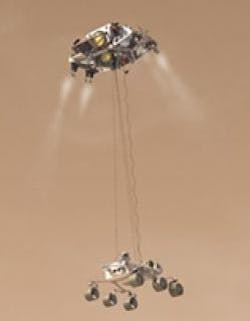Descent Brake from Sierra Nevada Corp. to help land NASA's Mars Science Laboratory
SPARKS, Nev., 19 Dec. 2011. The Descent Brake built by engineers at Sierra Nevada Corp.’s (SNC’s) Space Systems business unit in Louisville, Colo., is employed in the NASA Mars Science Laboratory (MSL) mission to Mars. The MSL, built by engineers at NASA’s Jet Propulsion Laboratory in Pasadena, Calif., will rely on the SNC-built Descent Brake to lower the 2,000-pound rover gently to the planet's surface—marking the first use of a “soft rover landing” technique for a Mars landing, says a company representative.
The nuclear-powered rover will also use Sierra Nevada’s gear technology, similar to that used on the Spirit and Opportunity rovers, to gather soil samples and process them into the different instruments for analysis. The mass of MSL prevents the use of airbags, prompting the development of a sky-crane method to lower the rover to the surface.
A bridle and "umbilical cord" will lower the rover, during which time the rover's front mobility system will be deployed. It will, thereby, be ready to rove upon landing in early Aug. 2012.
When the on-board computer senses that touchdown is successful, it will cut the bridle. The descent stage then pitches away from the rover and powers away at full throttle to a crash-landing far from the rover.
